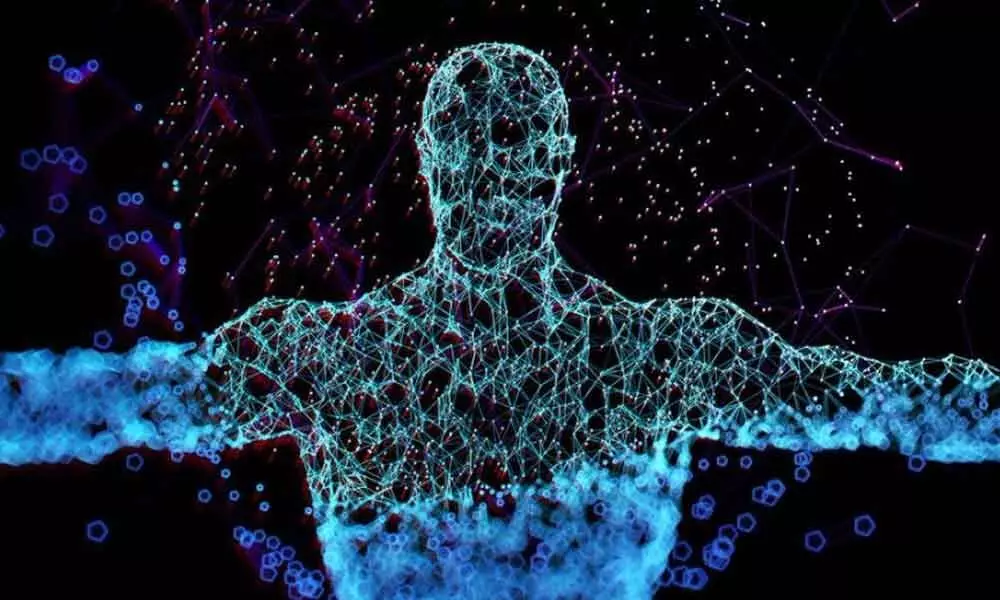Live
- Nizamabad MP Dharmapuri Arvind and Jagtial MLA Dr. Sanjay Kumar Meet CM Revanth Reddy
- Hyderabad CP CV Anand Issues Stern Warning to Bouncers
- MP Laxman Criticizes Police Conduct, Calls for Support for Victims' Families
- Fire Breaks Out in Kachiguda-Chennai Egmore Express, Passengers Evacuated Safely
- CM Revanth Reddy Condemns Attacks on Film Personalities' Homes, Calls for Strict Action
- Victory Venkatesh and Nandamuri Balakrishna to Set Screens on Fire with Unstoppable Season 4
- Over 71.81 crore Ayushman Bharat Health Account numbers generated: Centre
- In special gesture, Kuwait's Prime Minister sees-off PM Modi at airport after conclusion of historic visit
- Veer crowned PGTI Ranking champion, Shaurya wins emerging player honour
- Sr National Badminton: Unseeded Rounak Chauhan, Adarshini Shri reach singles semis
Just In
Is the Augmented Human emerging into mainstream?


Representational Image
In our younger days, guys wearing glasses were teased by calling them ‘Four eyes.’ It seemed taboo to augment natural sight to many, while humans have been augmenting themselves for centuries; glasses augmented bad eyesight, and hearing aids augmented hearing disability.
In our younger days, guys wearing glasses were teased by calling them 'Four eyes.' It seemed taboo to augment natural sight to many, while humans have been augmenting themselves for centuries; glasses augmented bad eyesight, and hearing aids augmented hearing disability.
Futurists now want to explore how technology can help us live better and live longer. This move towards technologies that enhance human capabilities beyond the individual will potentially impact society.
In the coming years, human abilities can be significantly elevated by a mix of established, emerging, and nano-technologies. Technologies such as exoskeletons, ingestibles, implantables, injectables and brain-computer interfaces gradually take centre stage.
Augmented humanity creates an interaction between the digital and physical worlds, allowing "technologically enabled humans" to unleash their full potential and perform at supernatural levels. We already see exoskeletons support workers with weight lifting in US automotive plants and AR-enabled-smart glasses allow remote asset maintenance in the Covid-19 era.
For example, the smartphones you hold in hand can be considered an abstract form of augmentation. But true enhancement comes when the body goes through a drastic improvement, like running faster without having to be worried about your knee cartilage wearing out. Technological augmentation means improving the physical nature of human bodies.
The main emphasis has been towards helping people with disabilities and healing the sick. With bionics and prosthetic augmentation, so far, technology has come closer to helping disabled human beings. However, the idea of improving the normal human beings is also quickly catching up.
This market is expected to bring in more than $70 billion by 2022 and grow steadily through 2025 and beyond. This is a massive opportunity for both established and emerging tech providers to participate.
Some of the areas showing significant traction are AR and VR
ARVR already allows mental health professionals to deliver an immersive experience to their patients. The technology enables professionals to learn new things about human cognitive functions while leading health providers towards better treatments and outcomes.
Exoskeletons in workforce
Exoskeletons enable next-generation augmentation of human capabilities, offering passive mechanical support to employees working in industries requiring heavy lifting. Industries such as automotive and transport are already augmenting and transforming the bodies of their workforce by providing workers with exoskeletons to increase employee productivity and safety. Ford Motor Company has partnered with a Bionics company and has rolled out quite a few upper body exoskeletons to support employees across more than a dozen of their automotive plants.
Wearables
Smartwatches monitoring heart rates, blood-oxygen, and blood-glucose levels via infrared sensor technology are frequently seen across consumers. Smart glasses that process data and display holographic information visualisation are experiencing a surge in demand as well.
Brain-computer interfaces (BCI)
BCI is a communication pathway between the brain and an external device. It translates human brain activity into an external action via neural commands, enabling humans to control machines without the physical constraints of the body, just by using their minds. In the future, amputees could directly control sophisticated prosthetic limbs, and people with impaired movement could use integration between exoskeletons and BCI to restore their movement functions.
Affective computing
BMW worked with this technology to examine the emotional in-cabin experience and understand how they can realise if drivers are falling asleep. This is helping automotive companies ensure road safety and enhance the driving experience by gaining insight into driver interactions and recognising drivers' levels of drowsiness, distraction, and anger.
Capsule cameras
Ingestible tech will innovate healthcare services. By swallowing a capsule camera, patients can go about their day as usual and access routine screening services from home. The imaging technology will provide a diagnosis within hours. An unprecedented capsule camera trial of 11,000 patients took place in England. Patients will trial this technology to replace traditional endoscopies, turning invasive in-hospital checks into delivered-at-home medical experiences.
Implantable Devices
Thousands of Swedish citizens use microchip implants to gain entrance to facilities, confirm their ID, or make payments. Their national rail company has already signed up 2,600 people to use microchips instead of train tickets.
The augmentation pipeline holds other great promises, such as bionic human joints, embedded scanning, chemical balancing systems to enhance physical activities, permanent, customisable contact lens, augmented skull, feet, and artificial windpipes for your throat. The possibilities are endless.
What's the final goal?
After reviewing the changes augmentation will bring to the human body, one cannot help but wonder what the ultimate augmented human would look like or what final goal humans will achieve. That remains to be seen, as enhancement is possible for almost all human body parts. The availability of the associated tech infrastructure will determine the pace of execution of this incredible technology in our daily lives.
(The author is the Chairman and CEO of Brightcom Group)

© 2024 Hyderabad Media House Limited/The Hans India. All rights reserved. Powered by hocalwire.com






